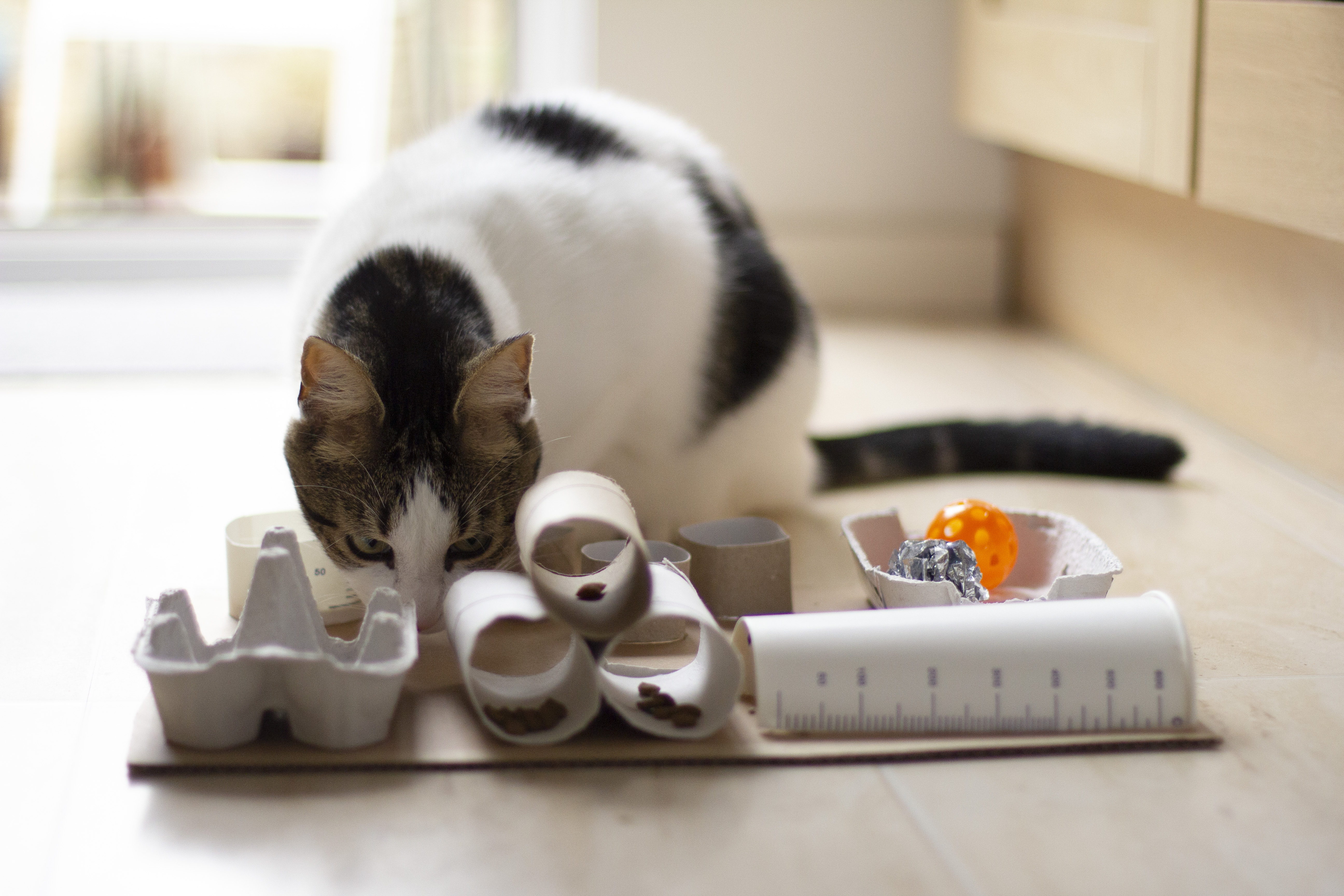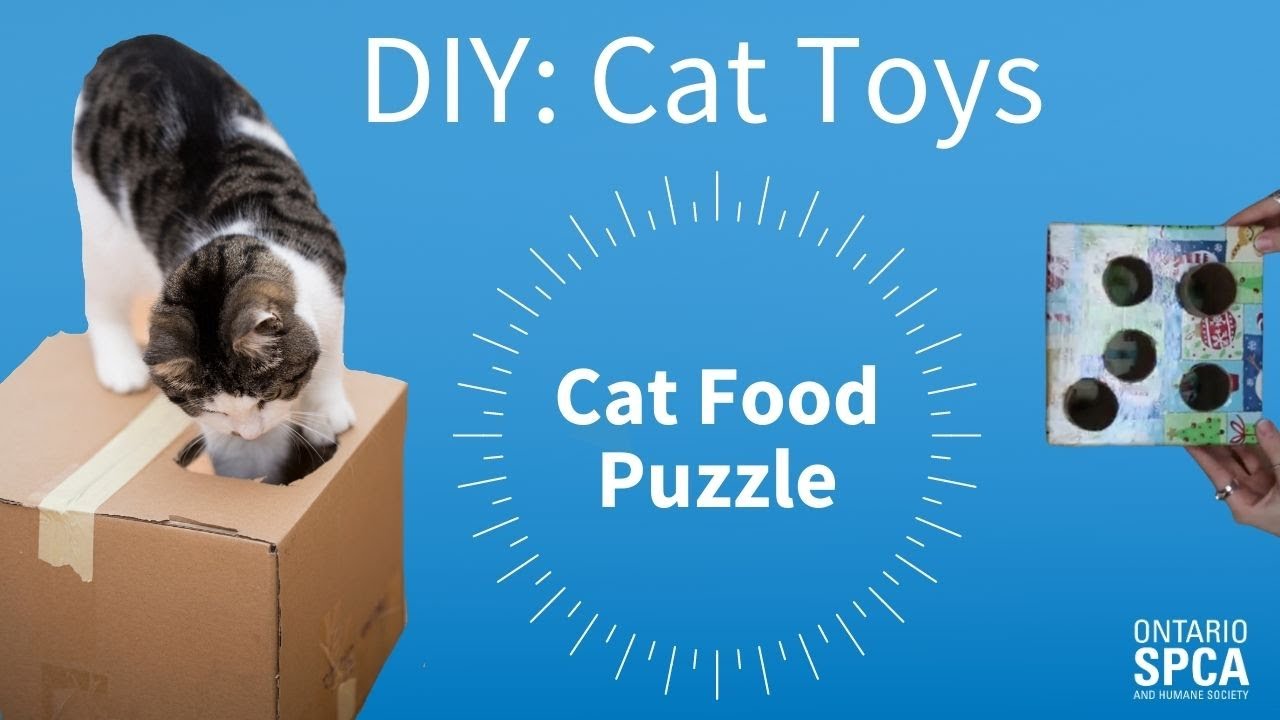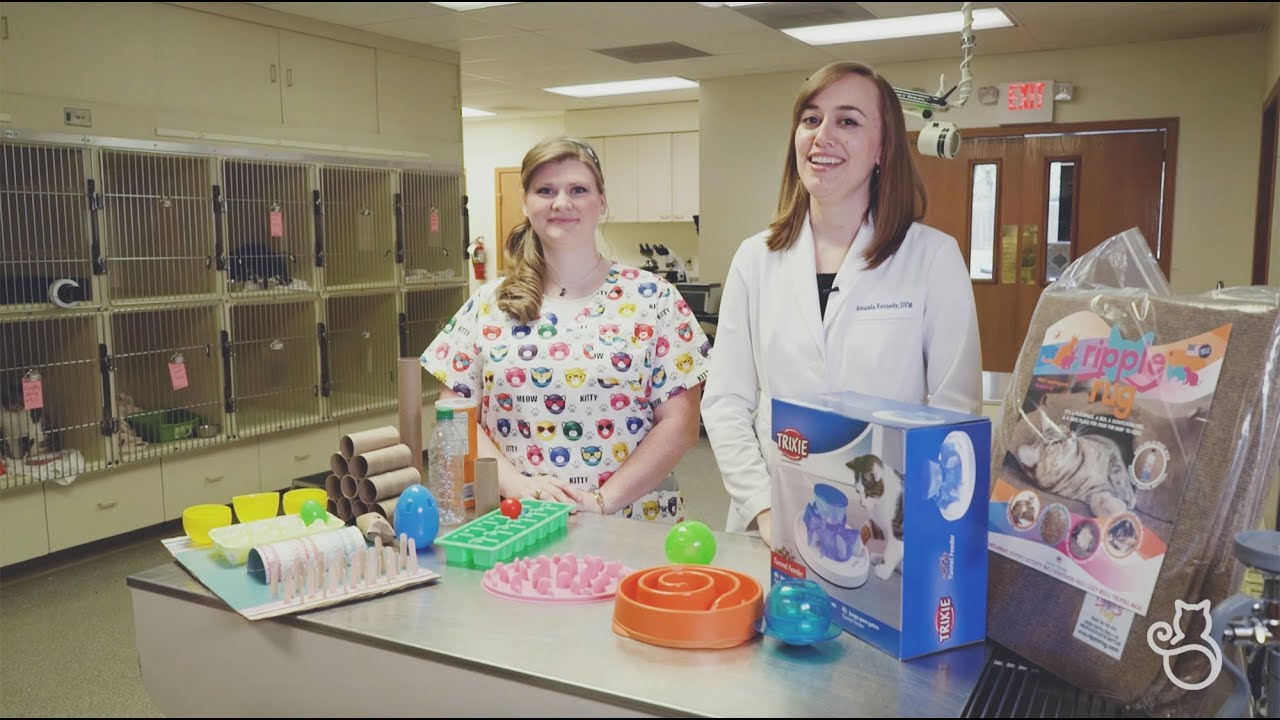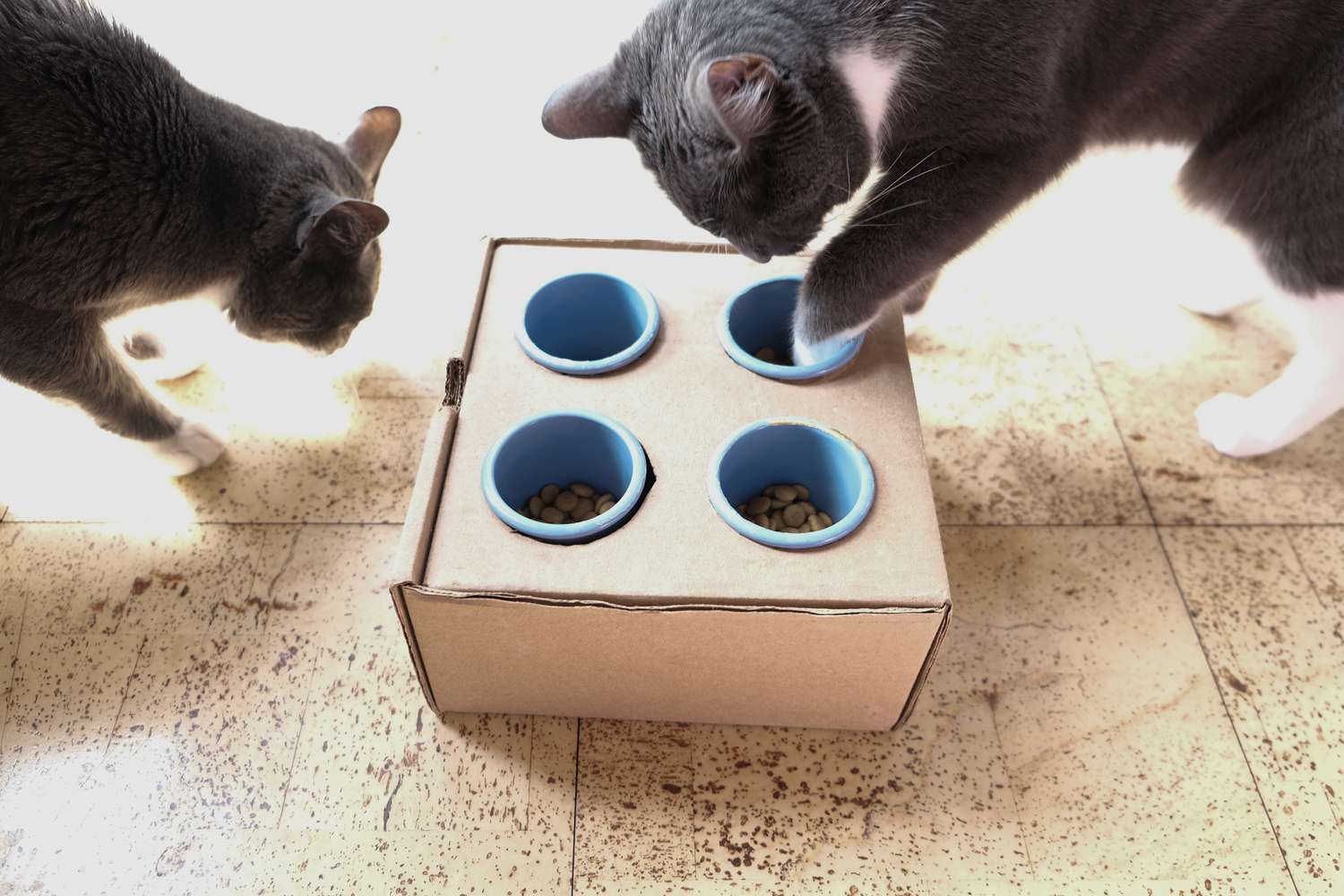
Cats have an instinctive urge to investigate, solve issues, and earn their food since they are natural hunters. But these instincts are frequently left unmet by modern domestication, which can result in boredom, worry, and even health issues.
Cat food puzzlesare one creative solution to these problems. Food puzzles are interactive toys that make your cat work for their food, which promotes better feeding habits, mental stimulation, and physical exercise.
We'll look deeply into the realm of cat food puzzles in this comprehensive guide, covering their types, advantages, how to make or select them, and advice on teaching your cat to utilize them.
What Are Cat Food Puzzles?
Cat food puzzles are specially designed toys or devices that challenge your cat to retrieve their food through problem-solving and physical manipulation. These puzzles mimic the hunting and foraging behavior that comes naturally to cats, making mealtime more engaging and rewarding.
They come in various forms, from commercially available toys to simple DIY projects. Some require your cat to bat, paw, or nudge objects to release kibble, while others involve sliding panels or tipping mechanisms to uncover hidden treats.
Benefits Of Cat Food Puzzles
- Mental Stimulation: Cats are intelligent creatures that thrive on mental challenges. Food puzzles encourage them to think, strategize, and solve problems, keeping their minds sharp and engaged. This is especially crucial for indoor cats who may lack other forms of stimulation.
- Encouraging Physical Activity: Cats must move in order to solve food puzzles, either they are chasing, pawing, or batting. Especially for overweight or inactive cats, this activity can help avoid obesity and associated health concerns like diabetes or joint disorders.
- Promoting Slower Eating: Cats who eat too quickly are prone to indigestion, bloating, and even vomiting. Food puzzles slow down the eating process, helping with digestion and preventing overeating. Incorporating foods to reduce inflammationinto your cat’s diet alongside puzzle feeders can further support their overall health and well-being.
- Reducing Boredom and Stress: Boredom and lack of stimulation can lead to stress, anxiety, and even destructive behaviors like scratching furniture or excessive meowing. Food puzzles offer an outlet for energy and curiosity, keeping your cat calm and content.
- Improving Behavioral Issues: Cats that experience food-related aggression or frustration often find food puzzles soothing. The puzzles give them a structured activity, reducing stress and encouraging positive behaviors.
- Strengthening Your Bond: Playing with puzzles with your cat improves your relationship. These moments spent together, whether you're teaching them how to use a puzzle or watching them solve it, are beneficial to you both. Adding puzzle gamesto your cat's routine not only provides mental stimulation but also strengthens the bond between you and your feline friend.
Types Of Cat Food Puzzles
1. Interactive Toys
Interactive food puzzle toys are engaging tools designed to challenge your cat while providing a fun way to retrieve kibble or treats. These toys often require your cat to bat, nudge, or chase them to release food, stimulating their hunting instincts and keeping them physically active.
Best For:Cats that love to play, chase, and use their paws to manipulate objects.
Example:A tumbler that releases kibble as it tips or rolls. Some models have adjustable difficulty levels, allowing you to increase the challenge as your cat gets better at using the toy.
Interactive toys are great for high-energy cats, as they combine mental stimulation with physical exercise, helping to prevent boredom and destructive behaviors.
2. Slow Feeders
Slow feeders are specially designed bowls or plates with grooves, ridges, or intricate patterns that make it harder for your cat to access their food quickly. These puzzles are ideal for cats that eat too fast, as they encourage slower eating and reduce the risk of digestive problems such as vomiting or bloating.
Best For:Cats prone to gulping down food or those with sensitive stomachs.
Example:A maze-shaped bowl that requires your cat to use their paw or tongue to navigate food through the grooves.
By slowing down mealtime, these feeders also extend the feeding experience, offering both mental stimulation and better portion control.
3. Automatic Feeders With Puzzles
These high-tech solutions combine convenience with mental engagement. Automatic feeders are programmed to release food at specific times, and when combined with puzzle trays, they add an element of surprise and challenge to feeding time. The food drops into a puzzle compartment, requiring your cat to work for their meal.
Best For:Cats left alone for extended periods or those on a strict feeding schedule.
Example:An automatic feeder that dispenses kibble into a rotating puzzle tray, forcing your cat to interact with it to access the food.
These feeders are ideal for busy pet owners, as they ensure your cat stays engaged and fed even when you’re not home.
4. DIY Cat Food Puzzles
Homemade puzzles are a creative and budget-friendly option. Using everyday household items, you can craft unique and stimulating puzzles that are customized to your cat’s preferences. Items like cardboard boxes, paper towel rolls, and plastic bottles can be repurposed to create fun challenges.
Best For:Pet owners who enjoy DIY projects and want affordable ways to keep their cats entertained.
Example:A cardboard box with multiple holes cut into it, where treats are hidden inside. Your cat must use their paw to fish out the food.
DIY puzzles not only save money but also allow you to experiment with different designs to find what your cat enjoys most. They are also easy to modify or replace if they wear out.
How To Make A Cat Food Puzzle With Simple Items

DIY Cat Food Puzzle
To start, gather these materials:
- 4 toilet roll tubes
- A piece of cardboard (at least 40x40 cm) for the base
- Empty plastic containers (yogurt pots, sauce containers, etc.)
- An empty egg carton
- Scissors or a craft knife (handle carefully)
- Super glue (make sure your cat doesn’t touch it while it dries)
Step-by-Step Instructions
1. Prepare The Base
To start, cut a square piece of cardboard about 40x40 cm. This will serve as the base of your puzzle and must be sturdy to support all the puzzle components. A stable base ensures that the puzzle doesn’t topple when your cat interacts with it. Use scissors or a craft knife to cut the cardboard, making sure the edges are smooth to avoid any sharp bits. Once ready, set the base aside for later use.
2. Make A Mini Tube Puzzle
Take one toilet roll tube and cut it in half horizontally to create two smaller tubes. These smaller tubes will act as treat holders in the puzzle, adding more variety for your cat to explore. Keep the mini tubes aside for assembly later.
3. Create A Pyramid
Use three toilet roll tubes to form a pyramid shape. Start by placing two tubes side by side to create the bottom layer. Then, place the third tube horizontally across the top of the two bottom tubes. To secure the structure, apply glue along the edges where the tubes touch each other. Hold them firmly for a few seconds until the glue sets slightly. Allow the pyramid to dry for a few minutes before attaching it to the base.
4. Prepare The Egg Carton
Separate the lid from an empty egg carton. Both parts will serve different purposes in the puzzle. The egg carton base, with its individual compartments, will hold treats that your cat can paw at to retrieve. The lid, when flipped upside down, can act as a shallow tray for scattering kibble or smaller treats. Keep both pieces ready for the assembly process.
5. Assemble The Puzzle
Take the cardboard base and begin attaching the prepared components. Glue the pyramid of toilet roll tubes onto one corner of the base. In another corner, secure the egg carton base and lid, placing them in a way that allows easy access for your cat.
In the remaining spaces on the base, attach the mini toilet roll tubes upright. Include additional plastic containers, such as yogurt or sauce pots, gluing them either upright or on their sides.
6. Let It Dry
Once all components are securely attached to the base, allow the entire structure to dry for about one hour. Place the puzzle in a safe area where your cat cannot reach it while the glue is setting. This step is crucial to prevent your pet from coming into contact with wet glue, which could be harmful.
7. Add The Treats
Once the puzzle is completely dry, start hiding treats or kibble in the various compartments. Place some inside the pyramid tubes, tuck others into the egg carton base, and scatter a few in the plastic containers. For the first few uses, leave a few treats in visible and easily accessible spots to help your cat understand how the puzzle works.
How To Train Your Cat To Use Food Puzzles
1. Introduce The Puzzle Gradually
The key to success is a gentle introduction. Start by placing a few treats or pieces of kibble around the outside of the puzzle to pique your cat’s curiosity. Allow them to sniff, paw, and explore without pressure. Once they’re comfortable approaching the puzzle, demonstrate how it works by moving or shaking the puzzle to release a treat. Seeing the reward will help them associate the puzzle with positive outcomes, encouraging them to try it themselves.
2. Use High-Value Rewards
To make the puzzle irresistible, use your cat’s favorite treats or highly desirable foods. These “high-value rewards” create excitement and motivation. For example, small bits of freeze-dried meat or their preferred kibble can work wonders. Ensure the treats are small enough to fit inside the puzzle compartments and easy for your cat to retrieve. Avoid using treats they don’t typically enjoy, as this may reduce their interest in interacting with the puzzle.
3. Encourage Exploration
Give your cat the freedom to approach the puzzle at their own pace. Avoid forcing interaction, as this can create stress or fear. If your cat seems hesitant, try placing a few treats in open compartments or easily accessible areas of the puzzle. Gradually increase the challenge as they become more confident. Natural detox foodscan further enhance their overall health and well-being when paired with engaging activities like puzzles.
4. Increase Difficulty Over Time
Once your cat successfully retrieves treats from the puzzle, introduce new challenges to keep them engaged. You can:
- Add more complex puzzles with deeper or narrower compartments.
- Hide treats in harder-to-reach areas of the existing puzzle.
- Mix in a variety of puzzles to maintain novelty.
Make sure to monitor your cat’s progress and adjust the difficulty according to their skill level. Avoid making the puzzle too challenging too quickly, as this could lead to frustration or loss of interest.
5. Monitor And Celebrate Success
Training your cat to use food puzzles is a process that requires patience and observation. Celebrate their successes, no matter how small, with rewards and encouragement. Over time, food puzzles can become a fun and enriching activity that not only entertains your cat but also supports their physical and mental well-being.

Food Puzzles and Food Enrichment for Your Cat
How To Choose The Right Puzzle For Your Cat
- Consider Your Cat’s Personality: Not all cats are equally curious or playful. Choose puzzles that match their temperament and energy levels.
- Start with Simplicity: Begin with easier puzzles for cats unfamiliar with food challenges. Gradually introduce more complexity as your cat gains confidence.
- Safety First: Ensure the puzzle is made of non-toxic, durable materials with no small parts that could be swallowed or cause harm.
- Durability and Ease of Cleaning: Look for puzzles that are easy to clean and can withstand daily use. Plastic puzzles are often dishwasher-safe, while wooden puzzles may require hand washing.
FAQs
How Do I Ensure The Puzzle Is Safe For My Cat?
To make the puzzle safe, use non-toxic glue and thoroughly clean all materials, such as egg cartons and plastic containers, before assembly. Ensure there are no sharp edges on the cardboard or containers, and regularly inspect the puzzle for loose parts or damage that could pose a hazard.
Can I Use Alternative Materials If I Don’t Have Toilet Rolls Or Egg Cartons?
Yes, you can get creative with alternative materials. Small cardboard boxes, paper towel tubes, or even sturdy plastic cups can replace toilet rolls. For egg cartons, try muffin tins or ice cube trays as substitutes. Just ensure the materials are safe and sturdy.
What Treats Should I Use In The Puzzle?
You can use your cat's favorite kibble or small, healthy treats. Soft treats are also a good option but avoid anything sticky that may be difficult for your cat to retrieve or clean later. If your cat is on a specific diet, consult your veterinarian about appropriate treat options.
How Do I Get My Cat Interested In The Puzzle?
Start by placing treats in visible and easily accessible spots on the puzzle. Gradually increase the challenge by hiding the treats deeper in compartments. Encourage your cat with gentle guidance and positive reinforcement when it interacts with the puzzle.
How Often Should I Use The Cat Food Puzzle?
You can use the puzzle daily or a few times a week, depending on your cat's interest and energy level. It’s a great way to provide mental stimulation, especially during meal times, but avoid overusing it to keep the novelty alive.
Final Thoughts
Cat food puzzles are more than just feeding tools, they're a fun and engaging way to keep your cat active and happy. By incorporating one into your routine, you can improve your pet’s overall well-being while turning every meal into an exciting activity.
